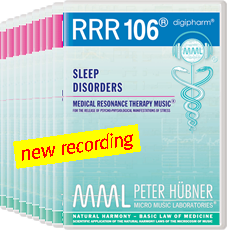| UNIVERSITY OF THE FUTURE |
| SCIENTIFICALLY INTRODUCING UNIVERSALITY TO THE UNIVERSITY |
|
| peter huebner • micro music laboratories |
| M E D I C A L R E S O N A N C E T H E R A P Y M U S I C® |
| R E D U C T I O N O F P S Y C H O – P H Y S I O L O G I C A L M A N I F E S T A T I O N S O F S T R E S S |
Scientific Studies and Clinical Observations
- Significant reduction in sleep disorders in 81% of a group of female diabetes patients.
- Improved sleep in 77% of the female patients with a mild form of OPH syndrome
- Reduction in sleep disorders in patients suffering from severe radiation sickness: prior to treatment 95% of the reports documented sleeping disorders; after 10 days’ treatment this had fallen to an average of only 17%
- Regular deep relaxation and relieving improvement in sleep in patients with psycho-vegetative syndrome
- Normalization of sleep following surgery in 70%, compared to 57% in the medication group
- Reduction in sleep disorders in 43% of patients with severe migraines
- Normalization of sleep in 61% of pregnant women, compared to 30% in the medication group
- Reduction in sleep disorders in pregnant women with somatic disorders. Prior to treatment incidence of recorded sleep disorders stood at 86%, after treatment this had fallen to only 7%.
In the control group: prior to treatment 50%, after treatment an increase to 80%.
If you want to look at the studies in detail, please visit:
